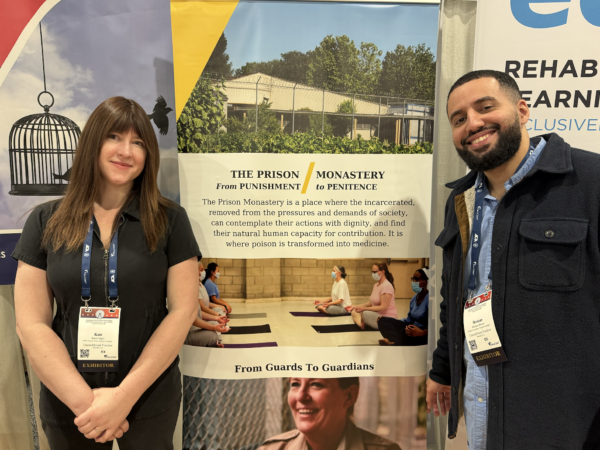Kate Feigin and Hesham Hauter at American Correctional Association Conference in Maryland this past January
by Kate Feigin
“Hold my beer while I test out this taser.” The voice boomed behind me as I worked to find my bearings in the crowded Expo Hall. Rows and rows of vendors peddled their wares to prison wardens and jail captains. An open bar offered beer, wine, and mixed drinks for people to enjoy while they shopped for holding cells and caged cars. There was a booth advertising nicotine vape pens sold to inmates at a large profit margin. A dog-like robot stalked the aisles, flipping over easily as the demo guy kicked it viciously, showing what would happen if it was in the center of a riot in a carceral facility.
We were invited to the American Correctional Association conference by our friends at Edovo, a nonprofit dedicated to providing high quality educational and wellness content on the tablets available to facilities across the United States. We shared a booth with Edovo and some of their other content providers who were all there to promote their wellness, recovery, and personal growth programs. Were we an island of… hope? Wellness? Crunchy optimism? In a churning sea of domination, exploitation, and subordination.
The Prison Monastery is a radically different approach to incarceration. It is based on the belief that human beings who have done wrong can transform if they are given the right conditions. We believe that if given the chance, we can change the way we incarcerate people in the United States. In doing so, we will create a ripple effect that will positively impact not only incarcerated people and correctional officers, but their families, and society.
You see, punishment is a two-way street. Paolo Freire said, “Dehumanization marks not only those whose humanity has been stolen, but also those who have stolen it. It is a distortion of the vocation of becoming more fully human.” (Freire, 1968) As a society, we set people to be punished for their crimes. We didn’t realize that punishment is a disease that affects all of us. The average life expectancy for a correctional officer is only 59 years, a full 16 years below the national average (NIMH 1997). Any solution we come up with must include officers as well.
Most of the captains and wardens gave us a side eye as they walked past, or said, “Good luck!” as they rolled their eyes.
A few, though, perhaps 5% were intrigued, excited even. They looked us deep in our eyes and instantly connected with the idea.
“This!” they said. “This is what we need!” They are the types who have seen what happens when an inhumane system creates cycles of harm, and they want something different. They understand that people need to be given the opportunity to connect with one another and the earth, contribute to society in a meaningful way, and go inward, finding themselves and their purpose—perhaps for the first time. It is these leaders we will align with, and we will bring them what we have created.
We have never pretended that changing the prison system from the ground up, from the inside out, and from the outside in would be easy. It won’t. It hasn’t been so far. We have had two cancellations in as many years and tremendous struggles in between. I have been asked many times why I keep doing this. Why not go get a job as a social worker or as a director somewhere else? I suppose it is because once you see a thing as clearly as I have, you just can’t walk away. I crossed a bridge, and here I am. I can’t uncross it.
I know that we will change the carceral system in the United States through our small actions, one step at a time.
A licensed psychotherapist, Kate Feigin, MSW, is the Director of the Prison Monastery. She is also working on a PhD in Community Liberation and Indigenous Ecopsychology. Kate’s research focuses on changing the carceral ecosystem from one of punishment to one of community, transformation, and purpose.

 Get access to the monthly Rehumanization Magazine featuring contributors from the front lines of this effort—those living on Death Row, residents of the largest women’s prison in the world, renowned ecologists, the food insecure, and veteran correctional officers alike.
Get access to the monthly Rehumanization Magazine featuring contributors from the front lines of this effort—those living on Death Row, residents of the largest women’s prison in the world, renowned ecologists, the food insecure, and veteran correctional officers alike.